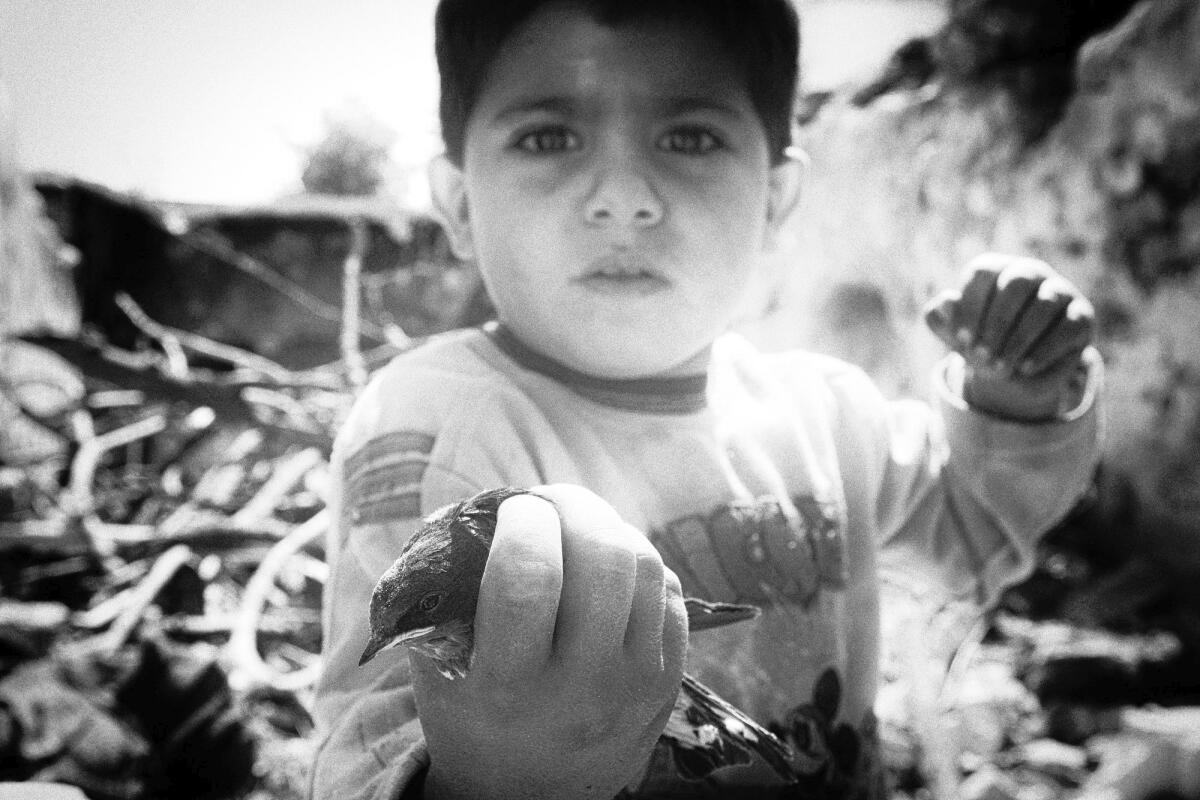An artist’s response to the Syrian conflict

- Share via
When Soulaf Abas returned to her home country of Syria in 2012, a year after the civil war began, what she saw shocked her.
She witnessed sniper fire, a bomb exploding in a building and her childhood home in Damascus reduced to a pile of rubble.
“It messed me up in many ways,” she said of the war, which started as a peaceful protest against President Bashar al-Assad’s government in 2011 but eventually turned into armed rebellion as Assad’s forces cracked down on the dissent.
The fighting has killed more than 200,000 Syrians and driven millions to flee their homes and seek sanctuary in other countries.
Soon after Abas returned to the United States, where she had spent the previous six years to attend college, including graduate school, she found out that her uncle, a human rights activist who had been imprisoned for 15 years for his work protesting the government, had died.
“That same day, I started painting about Syria,” she said, “and I haven’t stopped since.”
Abas spent the next three years painting images of Syria — destroyed city streets, a bomb blast, a child in agony.
These paintings, as well as photographs from Syria by Abas’ cousin, Muzaffar Salman, are now on display in an exhibition called “Seen For Syria” at the Orange County Center for Contemporary Art in Santa Ana.
While Abas said that painting was “therapeutic” for her in some ways, it was also painful. One example is her portrait, “In Syria I,” which was inspired by a photograph she saw of a man covered in his dead son’s blood.
“I would cry to the point where I couldn’t even see the canvas anymore,” she said. “It was such a hard painting to work on. I almost quit, and two months later I came back and said I need to finish this. Because if I don’t, I won’t know what it’s like to give this man as much attention and love as he deserves.”
Abas explained that oil paintings allow her to convey these intense feelings better than other artistic mediums.
“I don’t go for a highly realistic approach,” said Abas, who now teaches in the art department at Indiana State University. “The emotional expression is what’s really prominent in my work. It communicates beyond the literal and has a lot more to do with the heart rather than the mind.”
Alyssa Arney, co-curator of “Seen For Syria,” said it’s this emotional connection — and cutting through American stereotypes of the Middle East — that the show is all about.
“It’s this idea of empathy, trying to relate globally, through the works,” she said. “Some of us have never known a war-plagued life, or have had any traumas to that extent, but there’s a connection where we can all cry, we can all laugh. These are the experiences we have in common. The show is about relating to these people and trying to understand where they’re coming from.”
Arney explained that the way she constructed the exhibition was also designed to heighten emotion.
“There are certain installation pieces where Abas painted dead or mauled faces, and we position them not on the wall, but we have them laying on these long slabs that almost look like coffins or mass graves,” she said. “So you, as the viewer, are coming around the corners and looking at these dead faces on the ground.”
“It’s really impactful,” Arney went on, “and it feels very visceral when you’re experiencing this firsthand.”
In addition to Abas’ work, “Seen For Syria” also features photographs by Muzaffar Salman, who documented the Syrian civil war on the ground with images such as “Coming home to find your two sons killed by a missile” and “Waiting for the enemy in the kitchen.”
“Some of these images were taken while someone was shooting or about to shoot,” Abas said of Salman’s works, which have been displayed worldwide and in publications such as The New York Times and Time magazine. “He was in places where you would be shot or killed at any time. Yet he was exposing himself just to take that one photograph.”
While the exhibition focuses on the pain and destruction Syria has endured in the past four years, it also includes a message of hope.
“Seen For Syria” features the installation piece “Blooming Syria” by Abas and Arney, which includes a pile of dirt, a cup of seeds and a rock outline of a map of Syria. Visitors are invited to plant a seed inside the map as a way to symbolically rebuild the country.
The installation parallels a gardening project that Abas started while volunteering in Syrian refugee camps in Jordan.
“I had been painting, but it felt like it wasn’t enough,” she said. “So I raised enough money to go to Jordan and work overseas by selling my art online. We planted gardens in the shape of a map so Syrian children could grow their own home.
“As soon as we started doing the silhouette of the Syrian map on the ground, I said, ‘Why are we doing this?’” said Abas. “And they said, ‘We’re trying to grow Syria!’ And I said, ‘Yes, it’s a home no one can take away from you.’ It starts with seeds in the ground, and every week it grows a little bit more.”
More to Read
The biggest entertainment stories
Get our big stories about Hollywood, film, television, music, arts, culture and more right in your inbox as soon as they publish.
You may occasionally receive promotional content from the Los Angeles Times.










